External Environment of Virgin Airlines Report 2022
VerifiedAdded on 2022/09/27
|15
|4822
|24
AI Summary
N/A
Contribute Materials
Your contribution can guide someone’s learning journey. Share your
documents today.
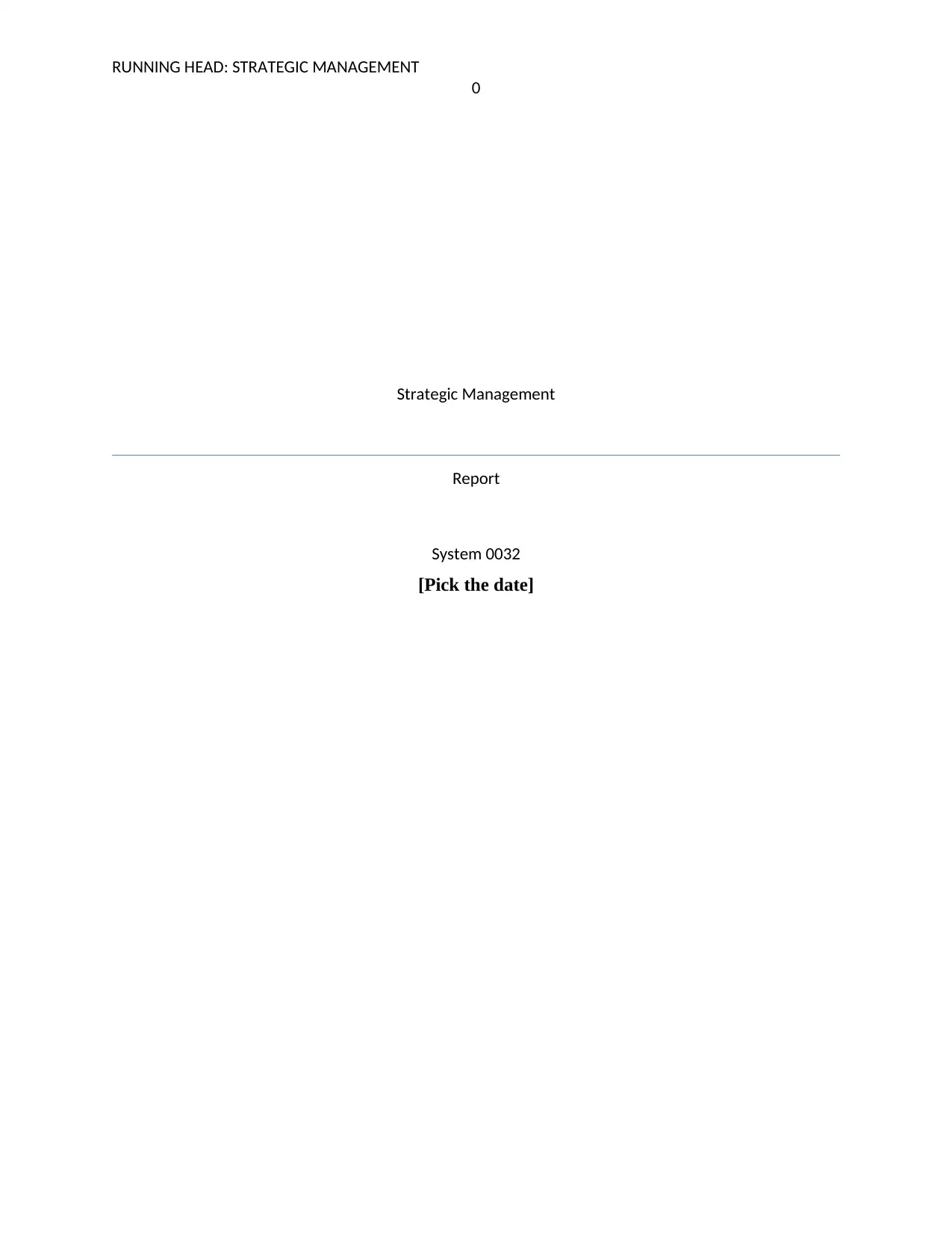
RUNNING HEAD: STRATEGIC MANAGEMENT
0
Strategic Management
Report
System 0032
[Pick the date]
0
Strategic Management
Report
System 0032
[Pick the date]
Secure Best Marks with AI Grader
Need help grading? Try our AI Grader for instant feedback on your assignments.
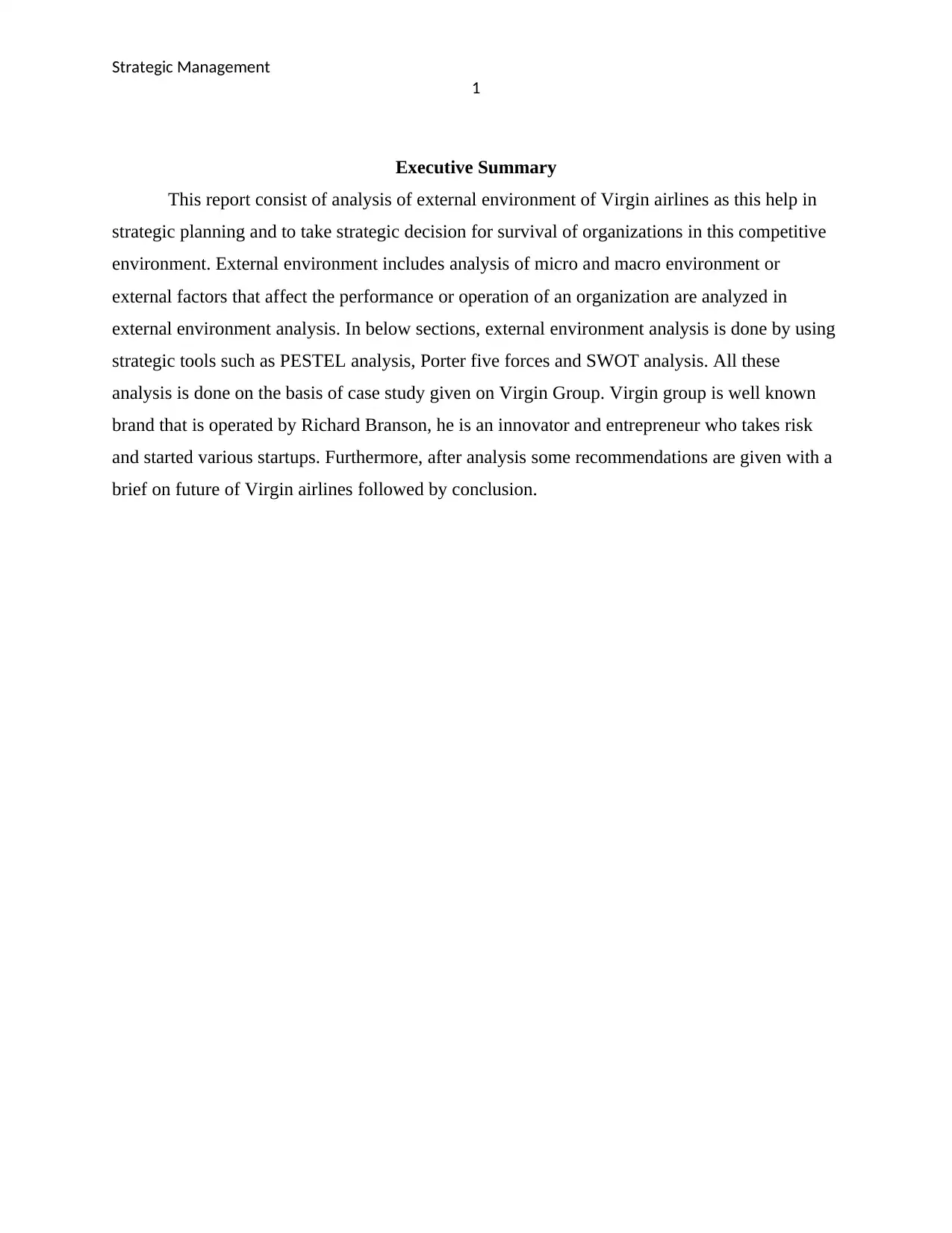
Strategic Management
1
Executive Summary
This report consist of analysis of external environment of Virgin airlines as this help in
strategic planning and to take strategic decision for survival of organizations in this competitive
environment. External environment includes analysis of micro and macro environment or
external factors that affect the performance or operation of an organization are analyzed in
external environment analysis. In below sections, external environment analysis is done by using
strategic tools such as PESTEL analysis, Porter five forces and SWOT analysis. All these
analysis is done on the basis of case study given on Virgin Group. Virgin group is well known
brand that is operated by Richard Branson, he is an innovator and entrepreneur who takes risk
and started various startups. Furthermore, after analysis some recommendations are given with a
brief on future of Virgin airlines followed by conclusion.
1
Executive Summary
This report consist of analysis of external environment of Virgin airlines as this help in
strategic planning and to take strategic decision for survival of organizations in this competitive
environment. External environment includes analysis of micro and macro environment or
external factors that affect the performance or operation of an organization are analyzed in
external environment analysis. In below sections, external environment analysis is done by using
strategic tools such as PESTEL analysis, Porter five forces and SWOT analysis. All these
analysis is done on the basis of case study given on Virgin Group. Virgin group is well known
brand that is operated by Richard Branson, he is an innovator and entrepreneur who takes risk
and started various startups. Furthermore, after analysis some recommendations are given with a
brief on future of Virgin airlines followed by conclusion.
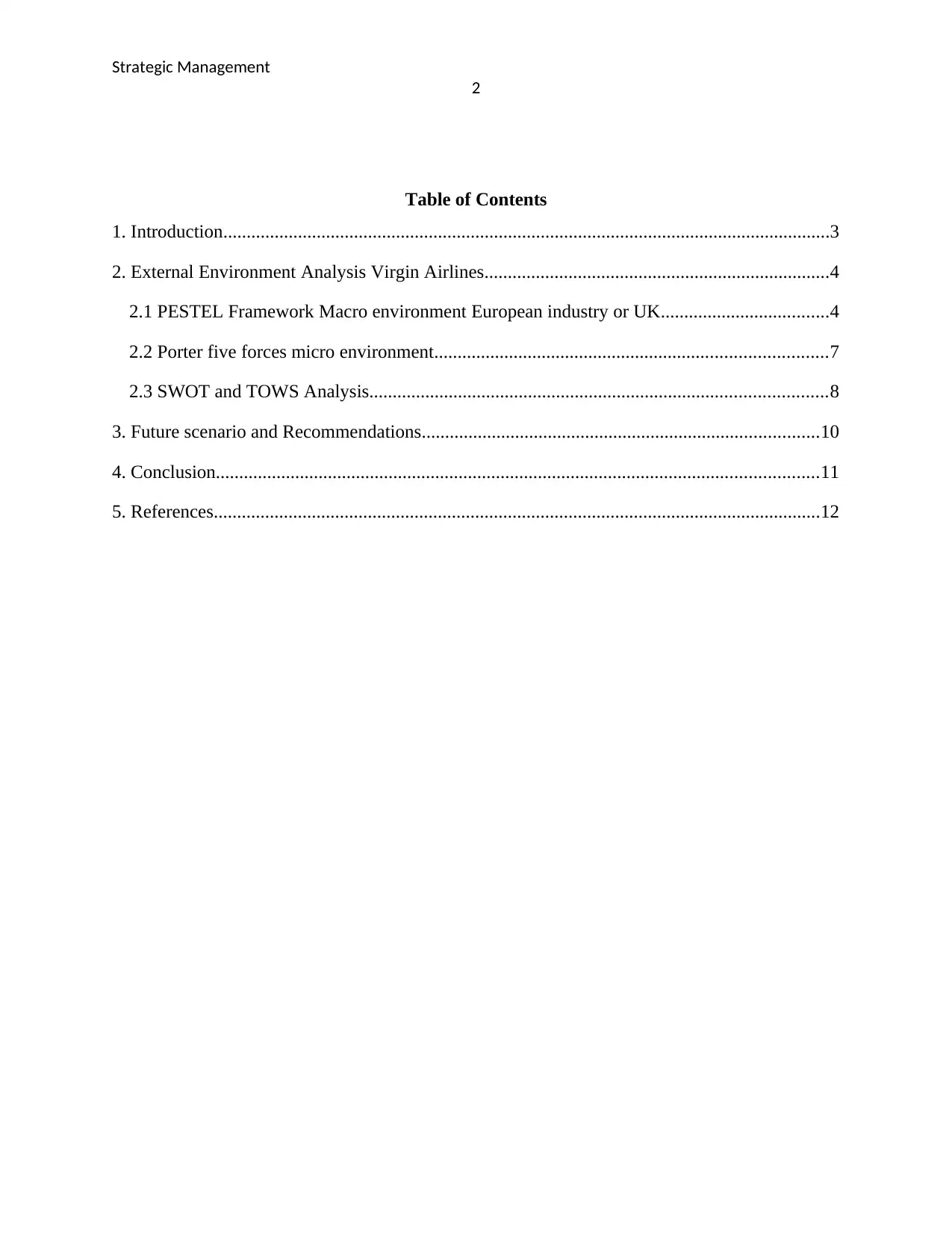
Strategic Management
2
Table of Contents
1. Introduction..................................................................................................................................3
2. External Environment Analysis Virgin Airlines..........................................................................4
2.1 PESTEL Framework Macro environment European industry or UK....................................4
2.2 Porter five forces micro environment....................................................................................7
2.3 SWOT and TOWS Analysis..................................................................................................8
3. Future scenario and Recommendations.....................................................................................10
4. Conclusion.................................................................................................................................11
5. References..................................................................................................................................12
2
Table of Contents
1. Introduction..................................................................................................................................3
2. External Environment Analysis Virgin Airlines..........................................................................4
2.1 PESTEL Framework Macro environment European industry or UK....................................4
2.2 Porter five forces micro environment....................................................................................7
2.3 SWOT and TOWS Analysis..................................................................................................8
3. Future scenario and Recommendations.....................................................................................10
4. Conclusion.................................................................................................................................11
5. References..................................................................................................................................12
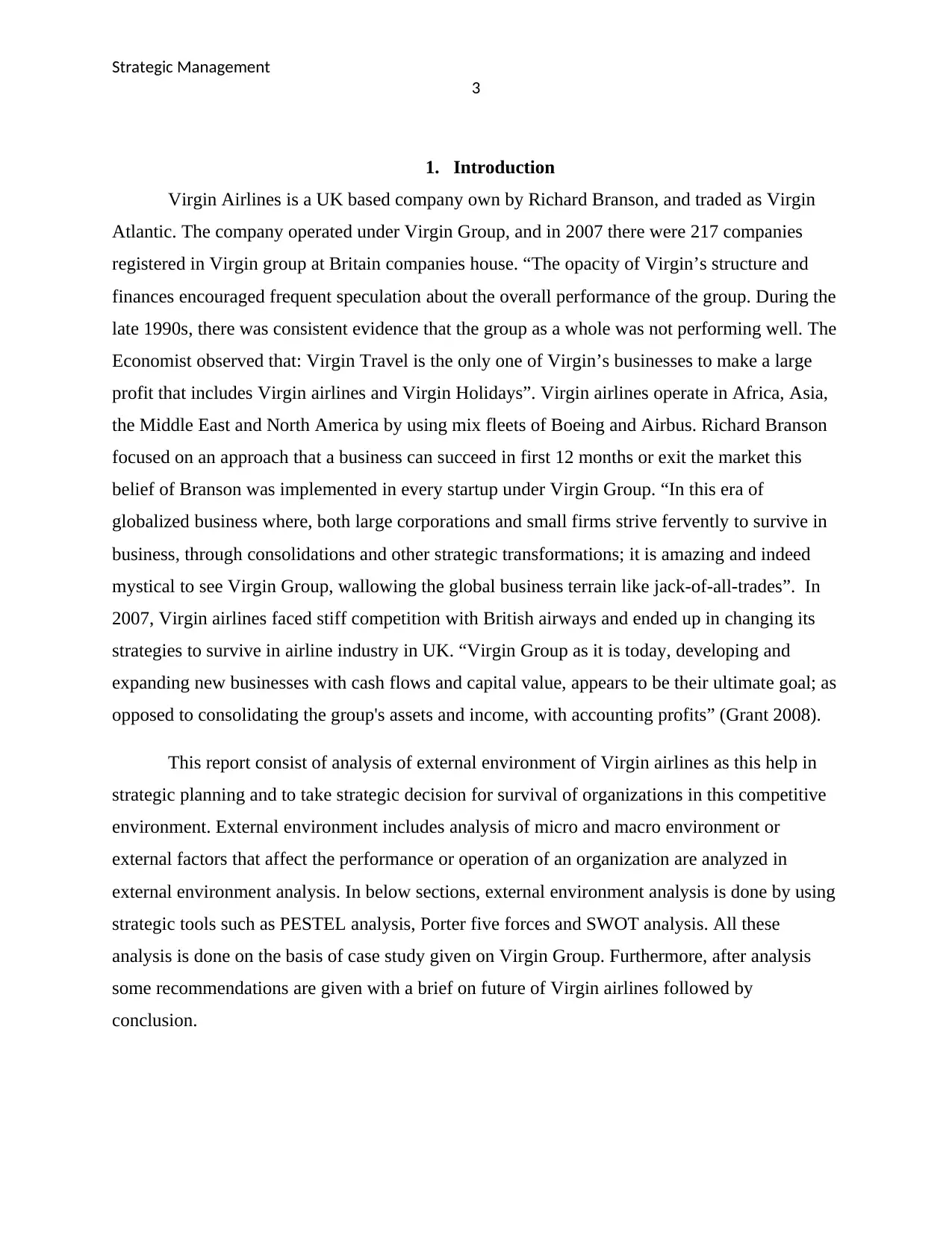
Strategic Management
3
1. Introduction
Virgin Airlines is a UK based company own by Richard Branson, and traded as Virgin
Atlantic. The company operated under Virgin Group, and in 2007 there were 217 companies
registered in Virgin group at Britain companies house. “The opacity of Virgin’s structure and
finances encouraged frequent speculation about the overall performance of the group. During the
late 1990s, there was consistent evidence that the group as a whole was not performing well. The
Economist observed that: Virgin Travel is the only one of Virgin’s businesses to make a large
profit that includes Virgin airlines and Virgin Holidays”. Virgin airlines operate in Africa, Asia,
the Middle East and North America by using mix fleets of Boeing and Airbus. Richard Branson
focused on an approach that a business can succeed in first 12 months or exit the market this
belief of Branson was implemented in every startup under Virgin Group. “In this era of
globalized business where, both large corporations and small firms strive fervently to survive in
business, through consolidations and other strategic transformations; it is amazing and indeed
mystical to see Virgin Group, wallowing the global business terrain like jack-of-all-trades”. In
2007, Virgin airlines faced stiff competition with British airways and ended up in changing its
strategies to survive in airline industry in UK. “Virgin Group as it is today, developing and
expanding new businesses with cash flows and capital value, appears to be their ultimate goal; as
opposed to consolidating the group's assets and income, with accounting profits” (Grant 2008).
This report consist of analysis of external environment of Virgin airlines as this help in
strategic planning and to take strategic decision for survival of organizations in this competitive
environment. External environment includes analysis of micro and macro environment or
external factors that affect the performance or operation of an organization are analyzed in
external environment analysis. In below sections, external environment analysis is done by using
strategic tools such as PESTEL analysis, Porter five forces and SWOT analysis. All these
analysis is done on the basis of case study given on Virgin Group. Furthermore, after analysis
some recommendations are given with a brief on future of Virgin airlines followed by
conclusion.
3
1. Introduction
Virgin Airlines is a UK based company own by Richard Branson, and traded as Virgin
Atlantic. The company operated under Virgin Group, and in 2007 there were 217 companies
registered in Virgin group at Britain companies house. “The opacity of Virgin’s structure and
finances encouraged frequent speculation about the overall performance of the group. During the
late 1990s, there was consistent evidence that the group as a whole was not performing well. The
Economist observed that: Virgin Travel is the only one of Virgin’s businesses to make a large
profit that includes Virgin airlines and Virgin Holidays”. Virgin airlines operate in Africa, Asia,
the Middle East and North America by using mix fleets of Boeing and Airbus. Richard Branson
focused on an approach that a business can succeed in first 12 months or exit the market this
belief of Branson was implemented in every startup under Virgin Group. “In this era of
globalized business where, both large corporations and small firms strive fervently to survive in
business, through consolidations and other strategic transformations; it is amazing and indeed
mystical to see Virgin Group, wallowing the global business terrain like jack-of-all-trades”. In
2007, Virgin airlines faced stiff competition with British airways and ended up in changing its
strategies to survive in airline industry in UK. “Virgin Group as it is today, developing and
expanding new businesses with cash flows and capital value, appears to be their ultimate goal; as
opposed to consolidating the group's assets and income, with accounting profits” (Grant 2008).
This report consist of analysis of external environment of Virgin airlines as this help in
strategic planning and to take strategic decision for survival of organizations in this competitive
environment. External environment includes analysis of micro and macro environment or
external factors that affect the performance or operation of an organization are analyzed in
external environment analysis. In below sections, external environment analysis is done by using
strategic tools such as PESTEL analysis, Porter five forces and SWOT analysis. All these
analysis is done on the basis of case study given on Virgin Group. Furthermore, after analysis
some recommendations are given with a brief on future of Virgin airlines followed by
conclusion.
Secure Best Marks with AI Grader
Need help grading? Try our AI Grader for instant feedback on your assignments.
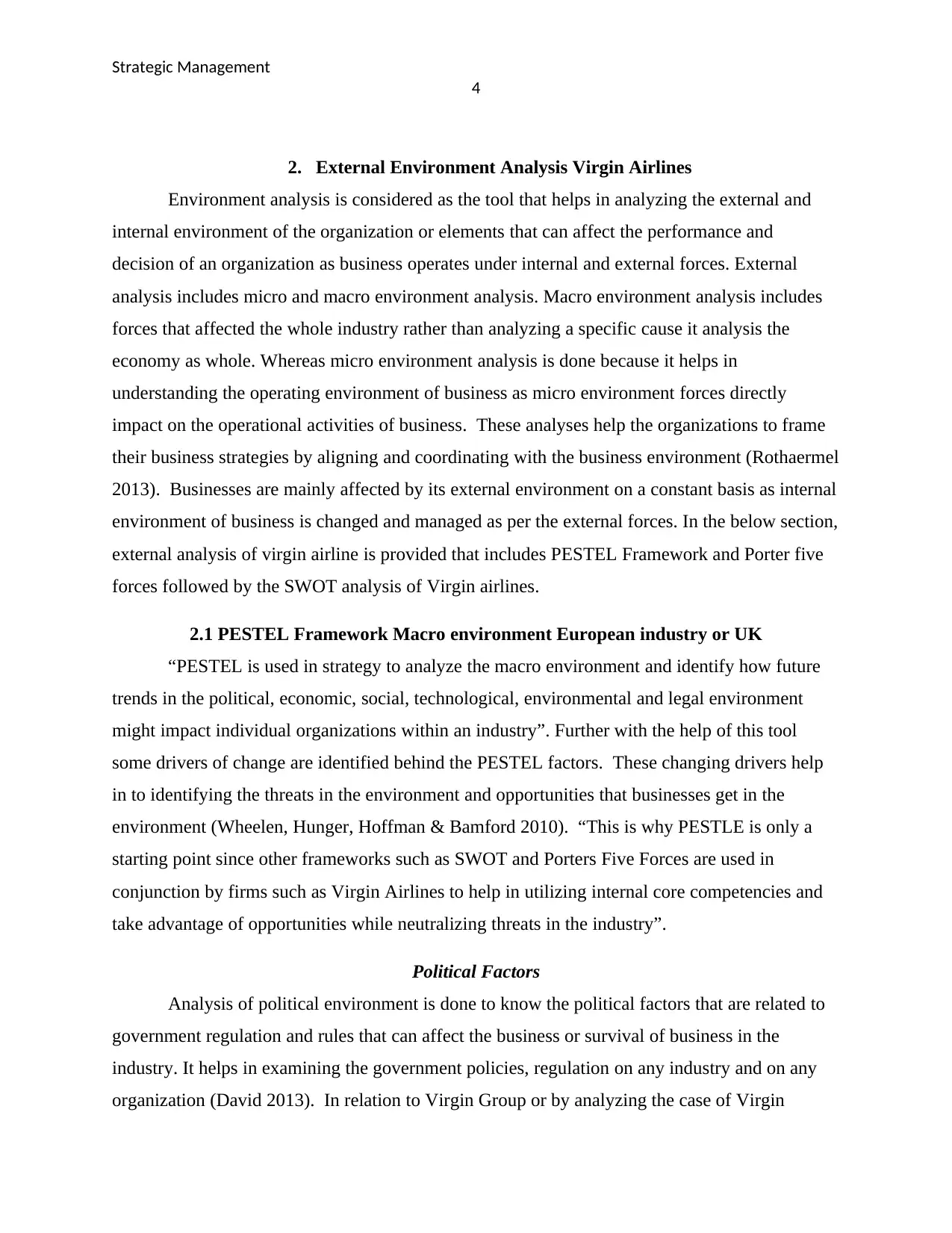
Strategic Management
4
2. External Environment Analysis Virgin Airlines
Environment analysis is considered as the tool that helps in analyzing the external and
internal environment of the organization or elements that can affect the performance and
decision of an organization as business operates under internal and external forces. External
analysis includes micro and macro environment analysis. Macro environment analysis includes
forces that affected the whole industry rather than analyzing a specific cause it analysis the
economy as whole. Whereas micro environment analysis is done because it helps in
understanding the operating environment of business as micro environment forces directly
impact on the operational activities of business. These analyses help the organizations to frame
their business strategies by aligning and coordinating with the business environment (Rothaermel
2013). Businesses are mainly affected by its external environment on a constant basis as internal
environment of business is changed and managed as per the external forces. In the below section,
external analysis of virgin airline is provided that includes PESTEL Framework and Porter five
forces followed by the SWOT analysis of Virgin airlines.
2.1 PESTEL Framework Macro environment European industry or UK
“PESTEL is used in strategy to analyze the macro environment and identify how future
trends in the political, economic, social, technological, environmental and legal environment
might impact individual organizations within an industry”. Further with the help of this tool
some drivers of change are identified behind the PESTEL factors. These changing drivers help
in to identifying the threats in the environment and opportunities that businesses get in the
environment (Wheelen, Hunger, Hoffman & Bamford 2010). “This is why PESTLE is only a
starting point since other frameworks such as SWOT and Porters Five Forces are used in
conjunction by firms such as Virgin Airlines to help in utilizing internal core competencies and
take advantage of opportunities while neutralizing threats in the industry”.
Political Factors
Analysis of political environment is done to know the political factors that are related to
government regulation and rules that can affect the business or survival of business in the
industry. It helps in examining the government policies, regulation on any industry and on any
organization (David 2013). In relation to Virgin Group or by analyzing the case of Virgin
4
2. External Environment Analysis Virgin Airlines
Environment analysis is considered as the tool that helps in analyzing the external and
internal environment of the organization or elements that can affect the performance and
decision of an organization as business operates under internal and external forces. External
analysis includes micro and macro environment analysis. Macro environment analysis includes
forces that affected the whole industry rather than analyzing a specific cause it analysis the
economy as whole. Whereas micro environment analysis is done because it helps in
understanding the operating environment of business as micro environment forces directly
impact on the operational activities of business. These analyses help the organizations to frame
their business strategies by aligning and coordinating with the business environment (Rothaermel
2013). Businesses are mainly affected by its external environment on a constant basis as internal
environment of business is changed and managed as per the external forces. In the below section,
external analysis of virgin airline is provided that includes PESTEL Framework and Porter five
forces followed by the SWOT analysis of Virgin airlines.
2.1 PESTEL Framework Macro environment European industry or UK
“PESTEL is used in strategy to analyze the macro environment and identify how future
trends in the political, economic, social, technological, environmental and legal environment
might impact individual organizations within an industry”. Further with the help of this tool
some drivers of change are identified behind the PESTEL factors. These changing drivers help
in to identifying the threats in the environment and opportunities that businesses get in the
environment (Wheelen, Hunger, Hoffman & Bamford 2010). “This is why PESTLE is only a
starting point since other frameworks such as SWOT and Porters Five Forces are used in
conjunction by firms such as Virgin Airlines to help in utilizing internal core competencies and
take advantage of opportunities while neutralizing threats in the industry”.
Political Factors
Analysis of political environment is done to know the political factors that are related to
government regulation and rules that can affect the business or survival of business in the
industry. It helps in examining the government policies, regulation on any industry and on any
organization (David 2013). In relation to Virgin Group or by analyzing the case of Virgin
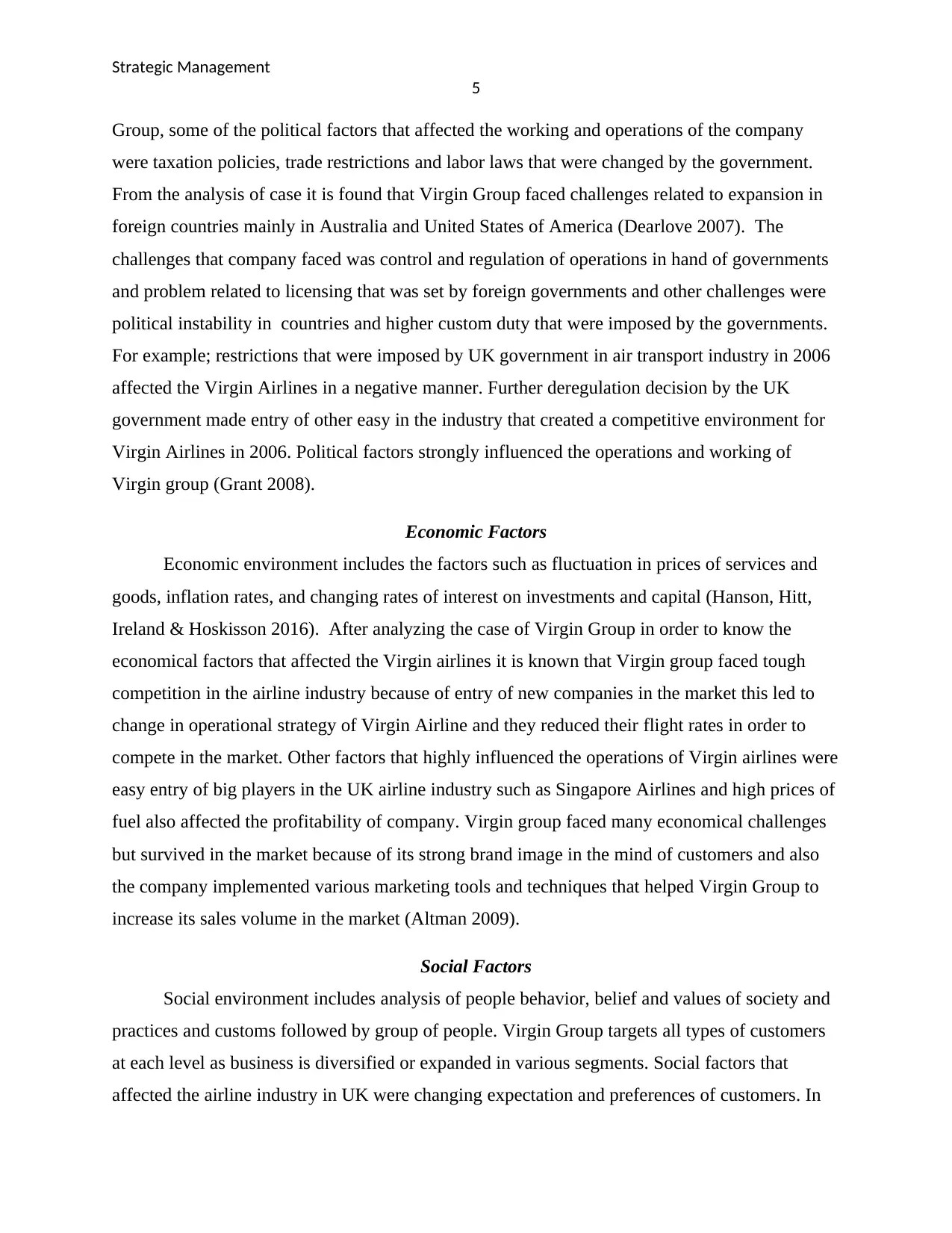
Strategic Management
5
Group, some of the political factors that affected the working and operations of the company
were taxation policies, trade restrictions and labor laws that were changed by the government.
From the analysis of case it is found that Virgin Group faced challenges related to expansion in
foreign countries mainly in Australia and United States of America (Dearlove 2007). The
challenges that company faced was control and regulation of operations in hand of governments
and problem related to licensing that was set by foreign governments and other challenges were
political instability in countries and higher custom duty that were imposed by the governments.
For example; restrictions that were imposed by UK government in air transport industry in 2006
affected the Virgin Airlines in a negative manner. Further deregulation decision by the UK
government made entry of other easy in the industry that created a competitive environment for
Virgin Airlines in 2006. Political factors strongly influenced the operations and working of
Virgin group (Grant 2008).
Economic Factors
Economic environment includes the factors such as fluctuation in prices of services and
goods, inflation rates, and changing rates of interest on investments and capital (Hanson, Hitt,
Ireland & Hoskisson 2016). After analyzing the case of Virgin Group in order to know the
economical factors that affected the Virgin airlines it is known that Virgin group faced tough
competition in the airline industry because of entry of new companies in the market this led to
change in operational strategy of Virgin Airline and they reduced their flight rates in order to
compete in the market. Other factors that highly influenced the operations of Virgin airlines were
easy entry of big players in the UK airline industry such as Singapore Airlines and high prices of
fuel also affected the profitability of company. Virgin group faced many economical challenges
but survived in the market because of its strong brand image in the mind of customers and also
the company implemented various marketing tools and techniques that helped Virgin Group to
increase its sales volume in the market (Altman 2009).
Social Factors
Social environment includes analysis of people behavior, belief and values of society and
practices and customs followed by group of people. Virgin Group targets all types of customers
at each level as business is diversified or expanded in various segments. Social factors that
affected the airline industry in UK were changing expectation and preferences of customers. In
5
Group, some of the political factors that affected the working and operations of the company
were taxation policies, trade restrictions and labor laws that were changed by the government.
From the analysis of case it is found that Virgin Group faced challenges related to expansion in
foreign countries mainly in Australia and United States of America (Dearlove 2007). The
challenges that company faced was control and regulation of operations in hand of governments
and problem related to licensing that was set by foreign governments and other challenges were
political instability in countries and higher custom duty that were imposed by the governments.
For example; restrictions that were imposed by UK government in air transport industry in 2006
affected the Virgin Airlines in a negative manner. Further deregulation decision by the UK
government made entry of other easy in the industry that created a competitive environment for
Virgin Airlines in 2006. Political factors strongly influenced the operations and working of
Virgin group (Grant 2008).
Economic Factors
Economic environment includes the factors such as fluctuation in prices of services and
goods, inflation rates, and changing rates of interest on investments and capital (Hanson, Hitt,
Ireland & Hoskisson 2016). After analyzing the case of Virgin Group in order to know the
economical factors that affected the Virgin airlines it is known that Virgin group faced tough
competition in the airline industry because of entry of new companies in the market this led to
change in operational strategy of Virgin Airline and they reduced their flight rates in order to
compete in the market. Other factors that highly influenced the operations of Virgin airlines were
easy entry of big players in the UK airline industry such as Singapore Airlines and high prices of
fuel also affected the profitability of company. Virgin group faced many economical challenges
but survived in the market because of its strong brand image in the mind of customers and also
the company implemented various marketing tools and techniques that helped Virgin Group to
increase its sales volume in the market (Altman 2009).
Social Factors
Social environment includes analysis of people behavior, belief and values of society and
practices and customs followed by group of people. Virgin Group targets all types of customers
at each level as business is diversified or expanded in various segments. Social factors that
affected the airline industry in UK were changing expectation and preferences of customers. In
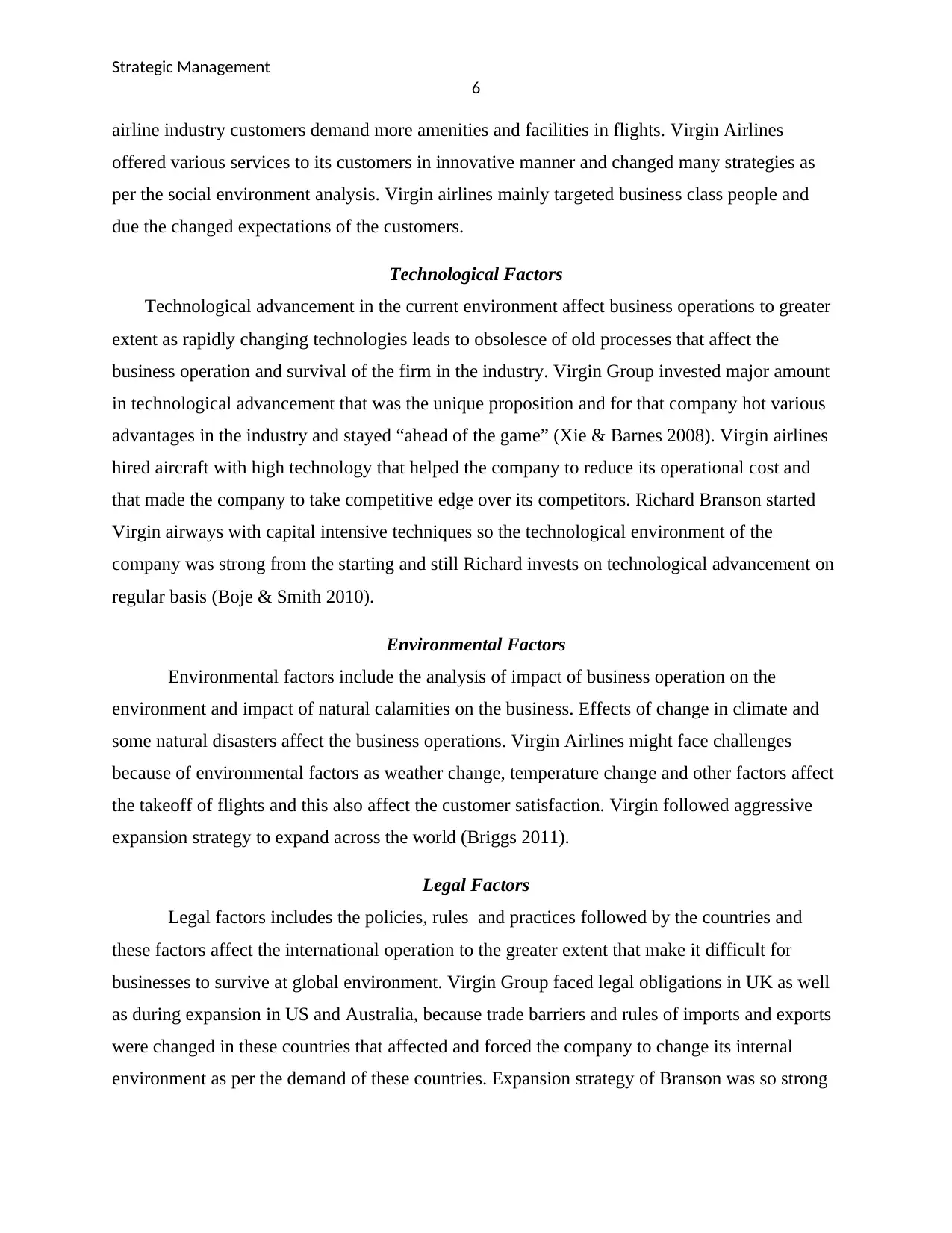
Strategic Management
6
airline industry customers demand more amenities and facilities in flights. Virgin Airlines
offered various services to its customers in innovative manner and changed many strategies as
per the social environment analysis. Virgin airlines mainly targeted business class people and
due the changed expectations of the customers.
Technological Factors
Technological advancement in the current environment affect business operations to greater
extent as rapidly changing technologies leads to obsolesce of old processes that affect the
business operation and survival of the firm in the industry. Virgin Group invested major amount
in technological advancement that was the unique proposition and for that company hot various
advantages in the industry and stayed “ahead of the game” (Xie & Barnes 2008). Virgin airlines
hired aircraft with high technology that helped the company to reduce its operational cost and
that made the company to take competitive edge over its competitors. Richard Branson started
Virgin airways with capital intensive techniques so the technological environment of the
company was strong from the starting and still Richard invests on technological advancement on
regular basis (Boje & Smith 2010).
Environmental Factors
Environmental factors include the analysis of impact of business operation on the
environment and impact of natural calamities on the business. Effects of change in climate and
some natural disasters affect the business operations. Virgin Airlines might face challenges
because of environmental factors as weather change, temperature change and other factors affect
the takeoff of flights and this also affect the customer satisfaction. Virgin followed aggressive
expansion strategy to expand across the world (Briggs 2011).
Legal Factors
Legal factors includes the policies, rules and practices followed by the countries and
these factors affect the international operation to the greater extent that make it difficult for
businesses to survive at global environment. Virgin Group faced legal obligations in UK as well
as during expansion in US and Australia, because trade barriers and rules of imports and exports
were changed in these countries that affected and forced the company to change its internal
environment as per the demand of these countries. Expansion strategy of Branson was so strong
6
airline industry customers demand more amenities and facilities in flights. Virgin Airlines
offered various services to its customers in innovative manner and changed many strategies as
per the social environment analysis. Virgin airlines mainly targeted business class people and
due the changed expectations of the customers.
Technological Factors
Technological advancement in the current environment affect business operations to greater
extent as rapidly changing technologies leads to obsolesce of old processes that affect the
business operation and survival of the firm in the industry. Virgin Group invested major amount
in technological advancement that was the unique proposition and for that company hot various
advantages in the industry and stayed “ahead of the game” (Xie & Barnes 2008). Virgin airlines
hired aircraft with high technology that helped the company to reduce its operational cost and
that made the company to take competitive edge over its competitors. Richard Branson started
Virgin airways with capital intensive techniques so the technological environment of the
company was strong from the starting and still Richard invests on technological advancement on
regular basis (Boje & Smith 2010).
Environmental Factors
Environmental factors include the analysis of impact of business operation on the
environment and impact of natural calamities on the business. Effects of change in climate and
some natural disasters affect the business operations. Virgin Airlines might face challenges
because of environmental factors as weather change, temperature change and other factors affect
the takeoff of flights and this also affect the customer satisfaction. Virgin followed aggressive
expansion strategy to expand across the world (Briggs 2011).
Legal Factors
Legal factors includes the policies, rules and practices followed by the countries and
these factors affect the international operation to the greater extent that make it difficult for
businesses to survive at global environment. Virgin Group faced legal obligations in UK as well
as during expansion in US and Australia, because trade barriers and rules of imports and exports
were changed in these countries that affected and forced the company to change its internal
environment as per the demand of these countries. Expansion strategy of Branson was so strong
Paraphrase This Document
Need a fresh take? Get an instant paraphrase of this document with our AI Paraphraser
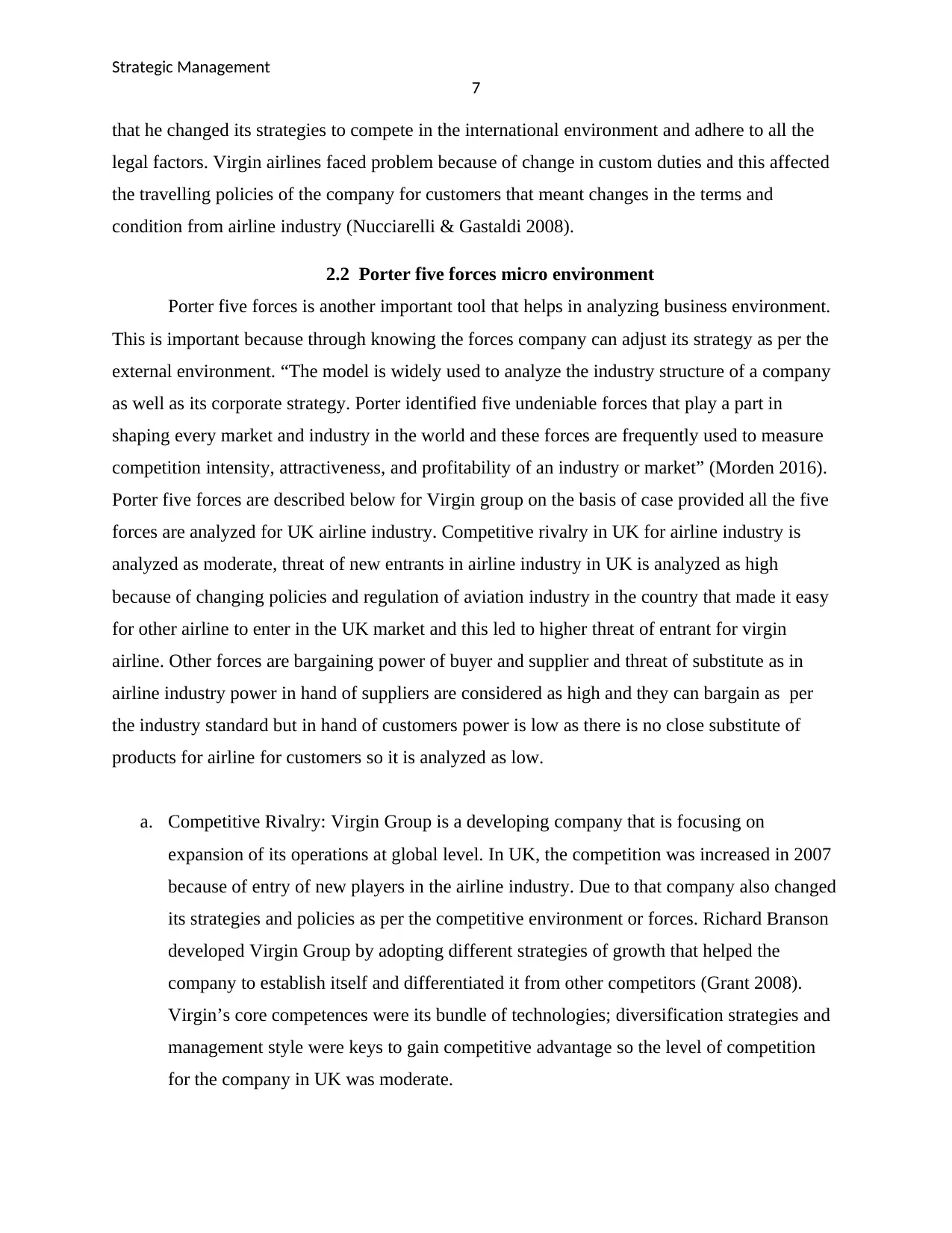
Strategic Management
7
that he changed its strategies to compete in the international environment and adhere to all the
legal factors. Virgin airlines faced problem because of change in custom duties and this affected
the travelling policies of the company for customers that meant changes in the terms and
condition from airline industry (Nucciarelli & Gastaldi 2008).
2.2 Porter five forces micro environment
Porter five forces is another important tool that helps in analyzing business environment.
This is important because through knowing the forces company can adjust its strategy as per the
external environment. “The model is widely used to analyze the industry structure of a company
as well as its corporate strategy. Porter identified five undeniable forces that play a part in
shaping every market and industry in the world and these forces are frequently used to measure
competition intensity, attractiveness, and profitability of an industry or market” (Morden 2016).
Porter five forces are described below for Virgin group on the basis of case provided all the five
forces are analyzed for UK airline industry. Competitive rivalry in UK for airline industry is
analyzed as moderate, threat of new entrants in airline industry in UK is analyzed as high
because of changing policies and regulation of aviation industry in the country that made it easy
for other airline to enter in the UK market and this led to higher threat of entrant for virgin
airline. Other forces are bargaining power of buyer and supplier and threat of substitute as in
airline industry power in hand of suppliers are considered as high and they can bargain as per
the industry standard but in hand of customers power is low as there is no close substitute of
products for airline for customers so it is analyzed as low.
a. Competitive Rivalry: Virgin Group is a developing company that is focusing on
expansion of its operations at global level. In UK, the competition was increased in 2007
because of entry of new players in the airline industry. Due to that company also changed
its strategies and policies as per the competitive environment or forces. Richard Branson
developed Virgin Group by adopting different strategies of growth that helped the
company to establish itself and differentiated it from other competitors (Grant 2008).
Virgin’s core competences were its bundle of technologies; diversification strategies and
management style were keys to gain competitive advantage so the level of competition
for the company in UK was moderate.
7
that he changed its strategies to compete in the international environment and adhere to all the
legal factors. Virgin airlines faced problem because of change in custom duties and this affected
the travelling policies of the company for customers that meant changes in the terms and
condition from airline industry (Nucciarelli & Gastaldi 2008).
2.2 Porter five forces micro environment
Porter five forces is another important tool that helps in analyzing business environment.
This is important because through knowing the forces company can adjust its strategy as per the
external environment. “The model is widely used to analyze the industry structure of a company
as well as its corporate strategy. Porter identified five undeniable forces that play a part in
shaping every market and industry in the world and these forces are frequently used to measure
competition intensity, attractiveness, and profitability of an industry or market” (Morden 2016).
Porter five forces are described below for Virgin group on the basis of case provided all the five
forces are analyzed for UK airline industry. Competitive rivalry in UK for airline industry is
analyzed as moderate, threat of new entrants in airline industry in UK is analyzed as high
because of changing policies and regulation of aviation industry in the country that made it easy
for other airline to enter in the UK market and this led to higher threat of entrant for virgin
airline. Other forces are bargaining power of buyer and supplier and threat of substitute as in
airline industry power in hand of suppliers are considered as high and they can bargain as per
the industry standard but in hand of customers power is low as there is no close substitute of
products for airline for customers so it is analyzed as low.
a. Competitive Rivalry: Virgin Group is a developing company that is focusing on
expansion of its operations at global level. In UK, the competition was increased in 2007
because of entry of new players in the airline industry. Due to that company also changed
its strategies and policies as per the competitive environment or forces. Richard Branson
developed Virgin Group by adopting different strategies of growth that helped the
company to establish itself and differentiated it from other competitors (Grant 2008).
Virgin’s core competences were its bundle of technologies; diversification strategies and
management style were keys to gain competitive advantage so the level of competition
for the company in UK was moderate.
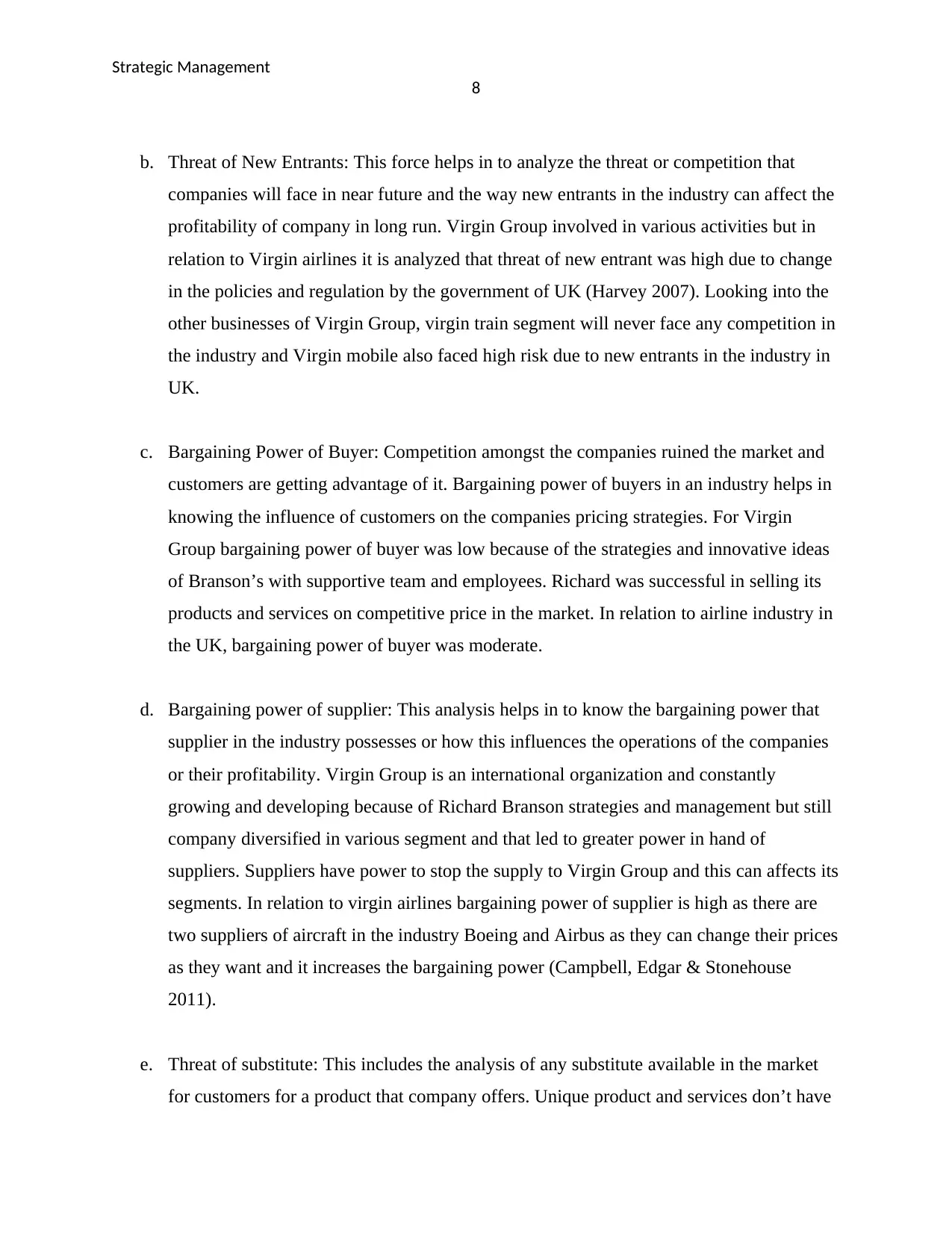
Strategic Management
8
b. Threat of New Entrants: This force helps in to analyze the threat or competition that
companies will face in near future and the way new entrants in the industry can affect the
profitability of company in long run. Virgin Group involved in various activities but in
relation to Virgin airlines it is analyzed that threat of new entrant was high due to change
in the policies and regulation by the government of UK (Harvey 2007). Looking into the
other businesses of Virgin Group, virgin train segment will never face any competition in
the industry and Virgin mobile also faced high risk due to new entrants in the industry in
UK.
c. Bargaining Power of Buyer: Competition amongst the companies ruined the market and
customers are getting advantage of it. Bargaining power of buyers in an industry helps in
knowing the influence of customers on the companies pricing strategies. For Virgin
Group bargaining power of buyer was low because of the strategies and innovative ideas
of Branson’s with supportive team and employees. Richard was successful in selling its
products and services on competitive price in the market. In relation to airline industry in
the UK, bargaining power of buyer was moderate.
d. Bargaining power of supplier: This analysis helps in to know the bargaining power that
supplier in the industry possesses or how this influences the operations of the companies
or their profitability. Virgin Group is an international organization and constantly
growing and developing because of Richard Branson strategies and management but still
company diversified in various segment and that led to greater power in hand of
suppliers. Suppliers have power to stop the supply to Virgin Group and this can affects its
segments. In relation to virgin airlines bargaining power of supplier is high as there are
two suppliers of aircraft in the industry Boeing and Airbus as they can change their prices
as they want and it increases the bargaining power (Campbell, Edgar & Stonehouse
2011).
e. Threat of substitute: This includes the analysis of any substitute available in the market
for customers for a product that company offers. Unique product and services don’t have
8
b. Threat of New Entrants: This force helps in to analyze the threat or competition that
companies will face in near future and the way new entrants in the industry can affect the
profitability of company in long run. Virgin Group involved in various activities but in
relation to Virgin airlines it is analyzed that threat of new entrant was high due to change
in the policies and regulation by the government of UK (Harvey 2007). Looking into the
other businesses of Virgin Group, virgin train segment will never face any competition in
the industry and Virgin mobile also faced high risk due to new entrants in the industry in
UK.
c. Bargaining Power of Buyer: Competition amongst the companies ruined the market and
customers are getting advantage of it. Bargaining power of buyers in an industry helps in
knowing the influence of customers on the companies pricing strategies. For Virgin
Group bargaining power of buyer was low because of the strategies and innovative ideas
of Branson’s with supportive team and employees. Richard was successful in selling its
products and services on competitive price in the market. In relation to airline industry in
the UK, bargaining power of buyer was moderate.
d. Bargaining power of supplier: This analysis helps in to know the bargaining power that
supplier in the industry possesses or how this influences the operations of the companies
or their profitability. Virgin Group is an international organization and constantly
growing and developing because of Richard Branson strategies and management but still
company diversified in various segment and that led to greater power in hand of
suppliers. Suppliers have power to stop the supply to Virgin Group and this can affects its
segments. In relation to virgin airlines bargaining power of supplier is high as there are
two suppliers of aircraft in the industry Boeing and Airbus as they can change their prices
as they want and it increases the bargaining power (Campbell, Edgar & Stonehouse
2011).
e. Threat of substitute: This includes the analysis of any substitute available in the market
for customers for a product that company offers. Unique product and services don’t have
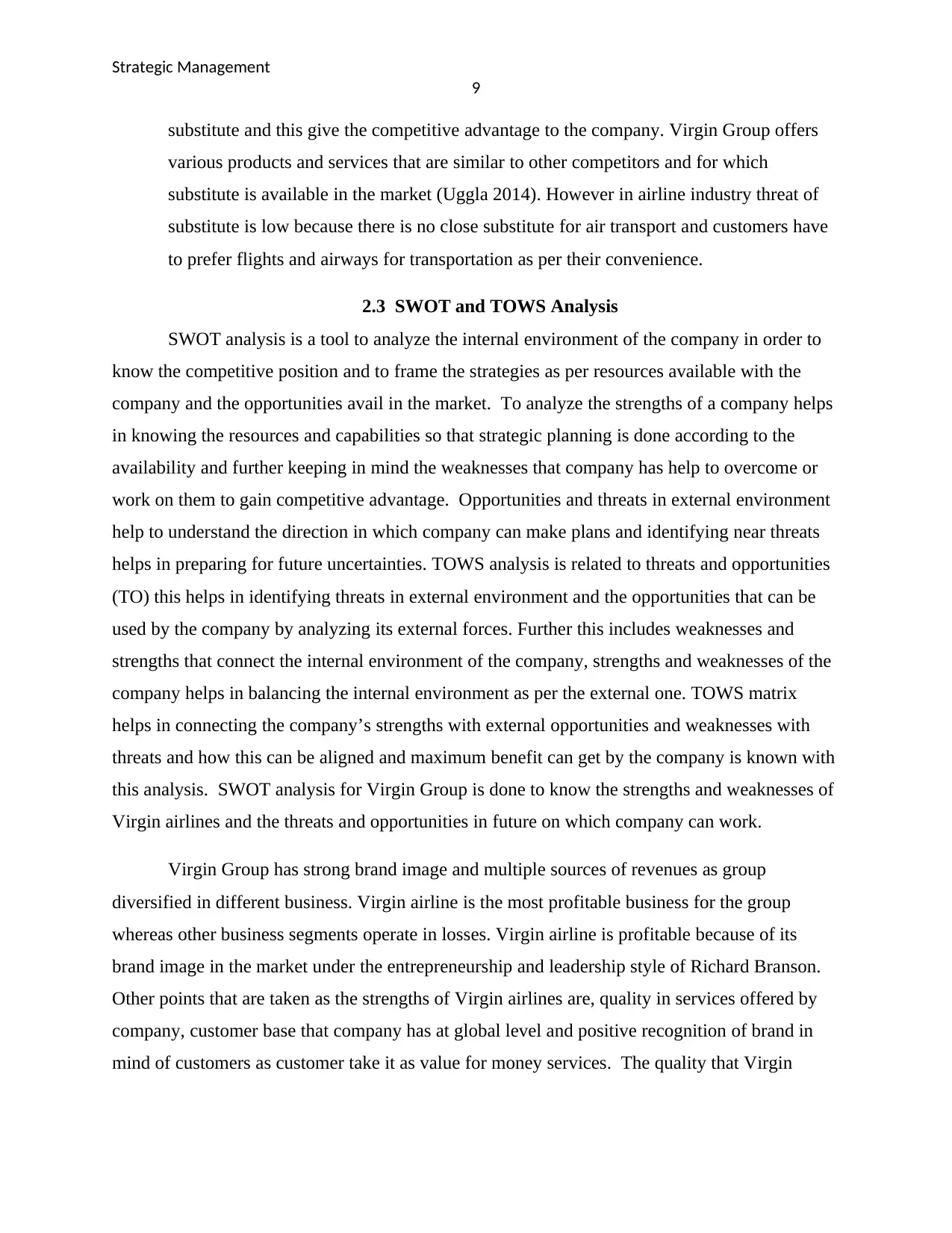
Strategic Management
9
substitute and this give the competitive advantage to the company. Virgin Group offers
various products and services that are similar to other competitors and for which
substitute is available in the market (Uggla 2014). However in airline industry threat of
substitute is low because there is no close substitute for air transport and customers have
to prefer flights and airways for transportation as per their convenience.
2.3 SWOT and TOWS Analysis
SWOT analysis is a tool to analyze the internal environment of the company in order to
know the competitive position and to frame the strategies as per resources available with the
company and the opportunities avail in the market. To analyze the strengths of a company helps
in knowing the resources and capabilities so that strategic planning is done according to the
availability and further keeping in mind the weaknesses that company has help to overcome or
work on them to gain competitive advantage. Opportunities and threats in external environment
help to understand the direction in which company can make plans and identifying near threats
helps in preparing for future uncertainties. TOWS analysis is related to threats and opportunities
(TO) this helps in identifying threats in external environment and the opportunities that can be
used by the company by analyzing its external forces. Further this includes weaknesses and
strengths that connect the internal environment of the company, strengths and weaknesses of the
company helps in balancing the internal environment as per the external one. TOWS matrix
helps in connecting the company’s strengths with external opportunities and weaknesses with
threats and how this can be aligned and maximum benefit can get by the company is known with
this analysis. SWOT analysis for Virgin Group is done to know the strengths and weaknesses of
Virgin airlines and the threats and opportunities in future on which company can work.
Virgin Group has strong brand image and multiple sources of revenues as group
diversified in different business. Virgin airline is the most profitable business for the group
whereas other business segments operate in losses. Virgin airline is profitable because of its
brand image in the market under the entrepreneurship and leadership style of Richard Branson.
Other points that are taken as the strengths of Virgin airlines are, quality in services offered by
company, customer base that company has at global level and positive recognition of brand in
mind of customers as customer take it as value for money services. The quality that Virgin
9
substitute and this give the competitive advantage to the company. Virgin Group offers
various products and services that are similar to other competitors and for which
substitute is available in the market (Uggla 2014). However in airline industry threat of
substitute is low because there is no close substitute for air transport and customers have
to prefer flights and airways for transportation as per their convenience.
2.3 SWOT and TOWS Analysis
SWOT analysis is a tool to analyze the internal environment of the company in order to
know the competitive position and to frame the strategies as per resources available with the
company and the opportunities avail in the market. To analyze the strengths of a company helps
in knowing the resources and capabilities so that strategic planning is done according to the
availability and further keeping in mind the weaknesses that company has help to overcome or
work on them to gain competitive advantage. Opportunities and threats in external environment
help to understand the direction in which company can make plans and identifying near threats
helps in preparing for future uncertainties. TOWS analysis is related to threats and opportunities
(TO) this helps in identifying threats in external environment and the opportunities that can be
used by the company by analyzing its external forces. Further this includes weaknesses and
strengths that connect the internal environment of the company, strengths and weaknesses of the
company helps in balancing the internal environment as per the external one. TOWS matrix
helps in connecting the company’s strengths with external opportunities and weaknesses with
threats and how this can be aligned and maximum benefit can get by the company is known with
this analysis. SWOT analysis for Virgin Group is done to know the strengths and weaknesses of
Virgin airlines and the threats and opportunities in future on which company can work.
Virgin Group has strong brand image and multiple sources of revenues as group
diversified in different business. Virgin airline is the most profitable business for the group
whereas other business segments operate in losses. Virgin airline is profitable because of its
brand image in the market under the entrepreneurship and leadership style of Richard Branson.
Other points that are taken as the strengths of Virgin airlines are, quality in services offered by
company, customer base that company has at global level and positive recognition of brand in
mind of customers as customer take it as value for money services. The quality that Virgin
Secure Best Marks with AI Grader
Need help grading? Try our AI Grader for instant feedback on your assignments.
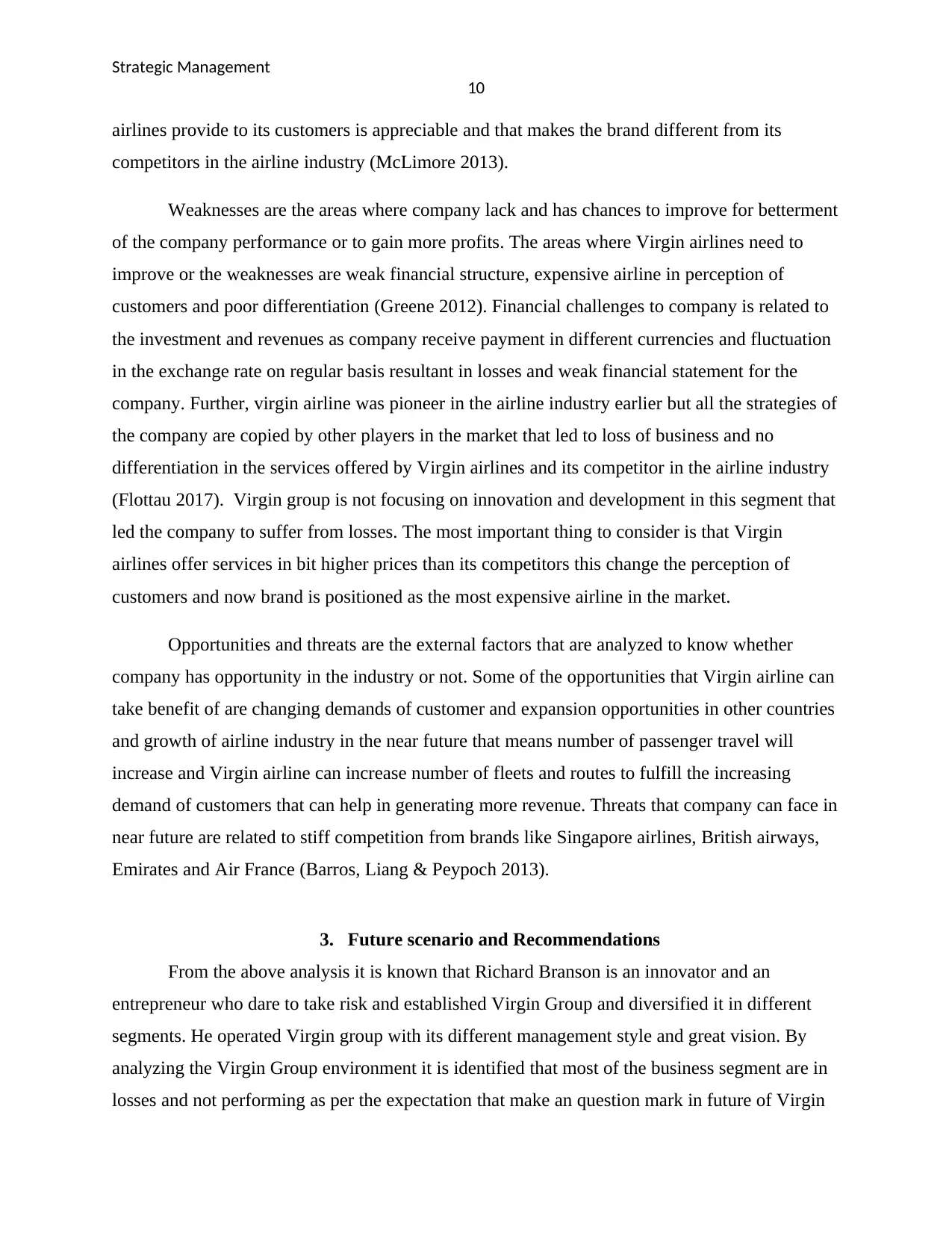
Strategic Management
10
airlines provide to its customers is appreciable and that makes the brand different from its
competitors in the airline industry (McLimore 2013).
Weaknesses are the areas where company lack and has chances to improve for betterment
of the company performance or to gain more profits. The areas where Virgin airlines need to
improve or the weaknesses are weak financial structure, expensive airline in perception of
customers and poor differentiation (Greene 2012). Financial challenges to company is related to
the investment and revenues as company receive payment in different currencies and fluctuation
in the exchange rate on regular basis resultant in losses and weak financial statement for the
company. Further, virgin airline was pioneer in the airline industry earlier but all the strategies of
the company are copied by other players in the market that led to loss of business and no
differentiation in the services offered by Virgin airlines and its competitor in the airline industry
(Flottau 2017). Virgin group is not focusing on innovation and development in this segment that
led the company to suffer from losses. The most important thing to consider is that Virgin
airlines offer services in bit higher prices than its competitors this change the perception of
customers and now brand is positioned as the most expensive airline in the market.
Opportunities and threats are the external factors that are analyzed to know whether
company has opportunity in the industry or not. Some of the opportunities that Virgin airline can
take benefit of are changing demands of customer and expansion opportunities in other countries
and growth of airline industry in the near future that means number of passenger travel will
increase and Virgin airline can increase number of fleets and routes to fulfill the increasing
demand of customers that can help in generating more revenue. Threats that company can face in
near future are related to stiff competition from brands like Singapore airlines, British airways,
Emirates and Air France (Barros, Liang & Peypoch 2013).
3. Future scenario and Recommendations
From the above analysis it is known that Richard Branson is an innovator and an
entrepreneur who dare to take risk and established Virgin Group and diversified it in different
segments. He operated Virgin group with its different management style and great vision. By
analyzing the Virgin Group environment it is identified that most of the business segment are in
losses and not performing as per the expectation that make an question mark in future of Virgin
10
airlines provide to its customers is appreciable and that makes the brand different from its
competitors in the airline industry (McLimore 2013).
Weaknesses are the areas where company lack and has chances to improve for betterment
of the company performance or to gain more profits. The areas where Virgin airlines need to
improve or the weaknesses are weak financial structure, expensive airline in perception of
customers and poor differentiation (Greene 2012). Financial challenges to company is related to
the investment and revenues as company receive payment in different currencies and fluctuation
in the exchange rate on regular basis resultant in losses and weak financial statement for the
company. Further, virgin airline was pioneer in the airline industry earlier but all the strategies of
the company are copied by other players in the market that led to loss of business and no
differentiation in the services offered by Virgin airlines and its competitor in the airline industry
(Flottau 2017). Virgin group is not focusing on innovation and development in this segment that
led the company to suffer from losses. The most important thing to consider is that Virgin
airlines offer services in bit higher prices than its competitors this change the perception of
customers and now brand is positioned as the most expensive airline in the market.
Opportunities and threats are the external factors that are analyzed to know whether
company has opportunity in the industry or not. Some of the opportunities that Virgin airline can
take benefit of are changing demands of customer and expansion opportunities in other countries
and growth of airline industry in the near future that means number of passenger travel will
increase and Virgin airline can increase number of fleets and routes to fulfill the increasing
demand of customers that can help in generating more revenue. Threats that company can face in
near future are related to stiff competition from brands like Singapore airlines, British airways,
Emirates and Air France (Barros, Liang & Peypoch 2013).
3. Future scenario and Recommendations
From the above analysis it is known that Richard Branson is an innovator and an
entrepreneur who dare to take risk and established Virgin Group and diversified it in different
segments. He operated Virgin group with its different management style and great vision. By
analyzing the Virgin Group environment it is identified that most of the business segment are in
losses and not performing as per the expectation that make an question mark in future of Virgin
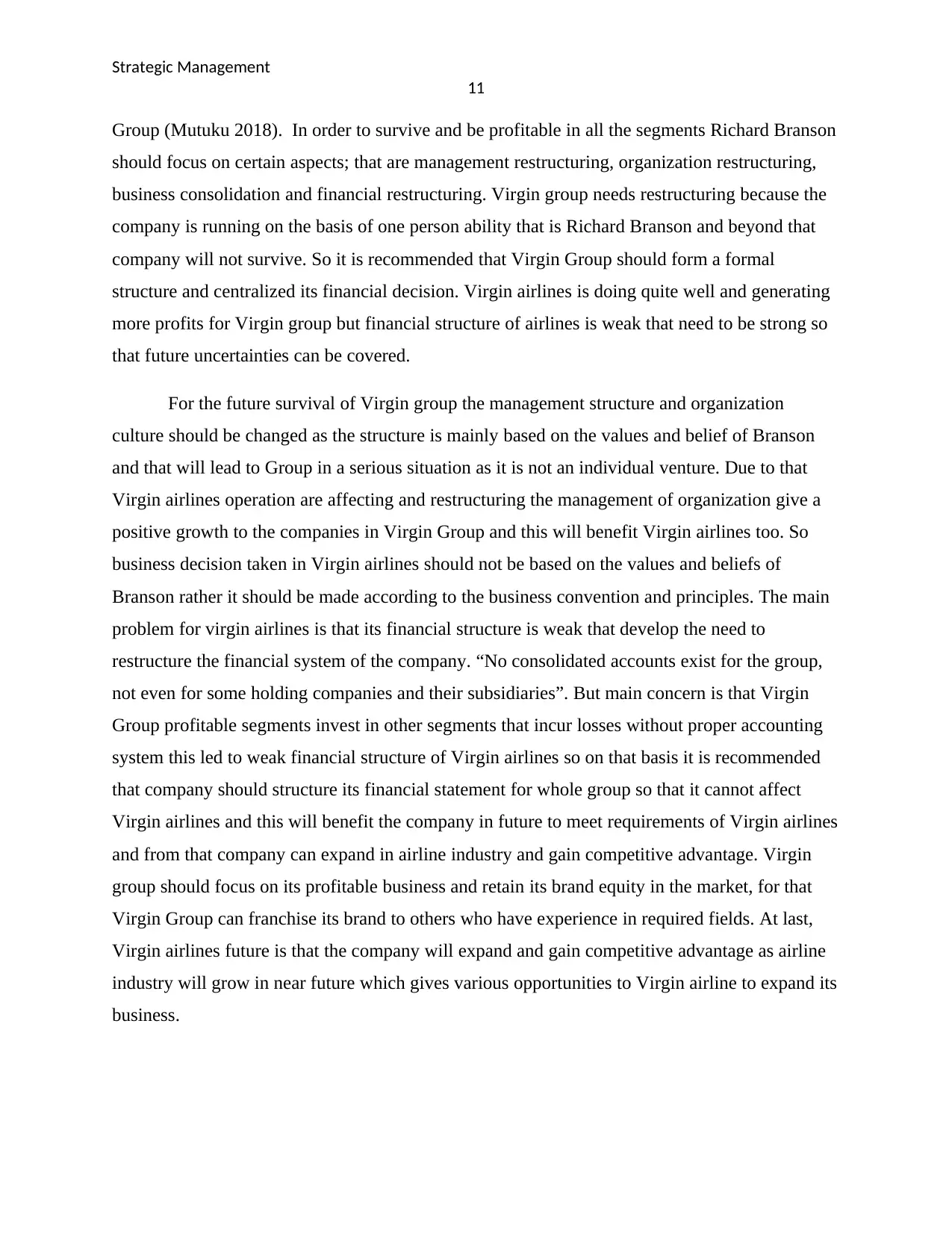
Strategic Management
11
Group (Mutuku 2018). In order to survive and be profitable in all the segments Richard Branson
should focus on certain aspects; that are management restructuring, organization restructuring,
business consolidation and financial restructuring. Virgin group needs restructuring because the
company is running on the basis of one person ability that is Richard Branson and beyond that
company will not survive. So it is recommended that Virgin Group should form a formal
structure and centralized its financial decision. Virgin airlines is doing quite well and generating
more profits for Virgin group but financial structure of airlines is weak that need to be strong so
that future uncertainties can be covered.
For the future survival of Virgin group the management structure and organization
culture should be changed as the structure is mainly based on the values and belief of Branson
and that will lead to Group in a serious situation as it is not an individual venture. Due to that
Virgin airlines operation are affecting and restructuring the management of organization give a
positive growth to the companies in Virgin Group and this will benefit Virgin airlines too. So
business decision taken in Virgin airlines should not be based on the values and beliefs of
Branson rather it should be made according to the business convention and principles. The main
problem for virgin airlines is that its financial structure is weak that develop the need to
restructure the financial system of the company. “No consolidated accounts exist for the group,
not even for some holding companies and their subsidiaries”. But main concern is that Virgin
Group profitable segments invest in other segments that incur losses without proper accounting
system this led to weak financial structure of Virgin airlines so on that basis it is recommended
that company should structure its financial statement for whole group so that it cannot affect
Virgin airlines and this will benefit the company in future to meet requirements of Virgin airlines
and from that company can expand in airline industry and gain competitive advantage. Virgin
group should focus on its profitable business and retain its brand equity in the market, for that
Virgin Group can franchise its brand to others who have experience in required fields. At last,
Virgin airlines future is that the company will expand and gain competitive advantage as airline
industry will grow in near future which gives various opportunities to Virgin airline to expand its
business.
11
Group (Mutuku 2018). In order to survive and be profitable in all the segments Richard Branson
should focus on certain aspects; that are management restructuring, organization restructuring,
business consolidation and financial restructuring. Virgin group needs restructuring because the
company is running on the basis of one person ability that is Richard Branson and beyond that
company will not survive. So it is recommended that Virgin Group should form a formal
structure and centralized its financial decision. Virgin airlines is doing quite well and generating
more profits for Virgin group but financial structure of airlines is weak that need to be strong so
that future uncertainties can be covered.
For the future survival of Virgin group the management structure and organization
culture should be changed as the structure is mainly based on the values and belief of Branson
and that will lead to Group in a serious situation as it is not an individual venture. Due to that
Virgin airlines operation are affecting and restructuring the management of organization give a
positive growth to the companies in Virgin Group and this will benefit Virgin airlines too. So
business decision taken in Virgin airlines should not be based on the values and beliefs of
Branson rather it should be made according to the business convention and principles. The main
problem for virgin airlines is that its financial structure is weak that develop the need to
restructure the financial system of the company. “No consolidated accounts exist for the group,
not even for some holding companies and their subsidiaries”. But main concern is that Virgin
Group profitable segments invest in other segments that incur losses without proper accounting
system this led to weak financial structure of Virgin airlines so on that basis it is recommended
that company should structure its financial statement for whole group so that it cannot affect
Virgin airlines and this will benefit the company in future to meet requirements of Virgin airlines
and from that company can expand in airline industry and gain competitive advantage. Virgin
group should focus on its profitable business and retain its brand equity in the market, for that
Virgin Group can franchise its brand to others who have experience in required fields. At last,
Virgin airlines future is that the company will expand and gain competitive advantage as airline
industry will grow in near future which gives various opportunities to Virgin airline to expand its
business.
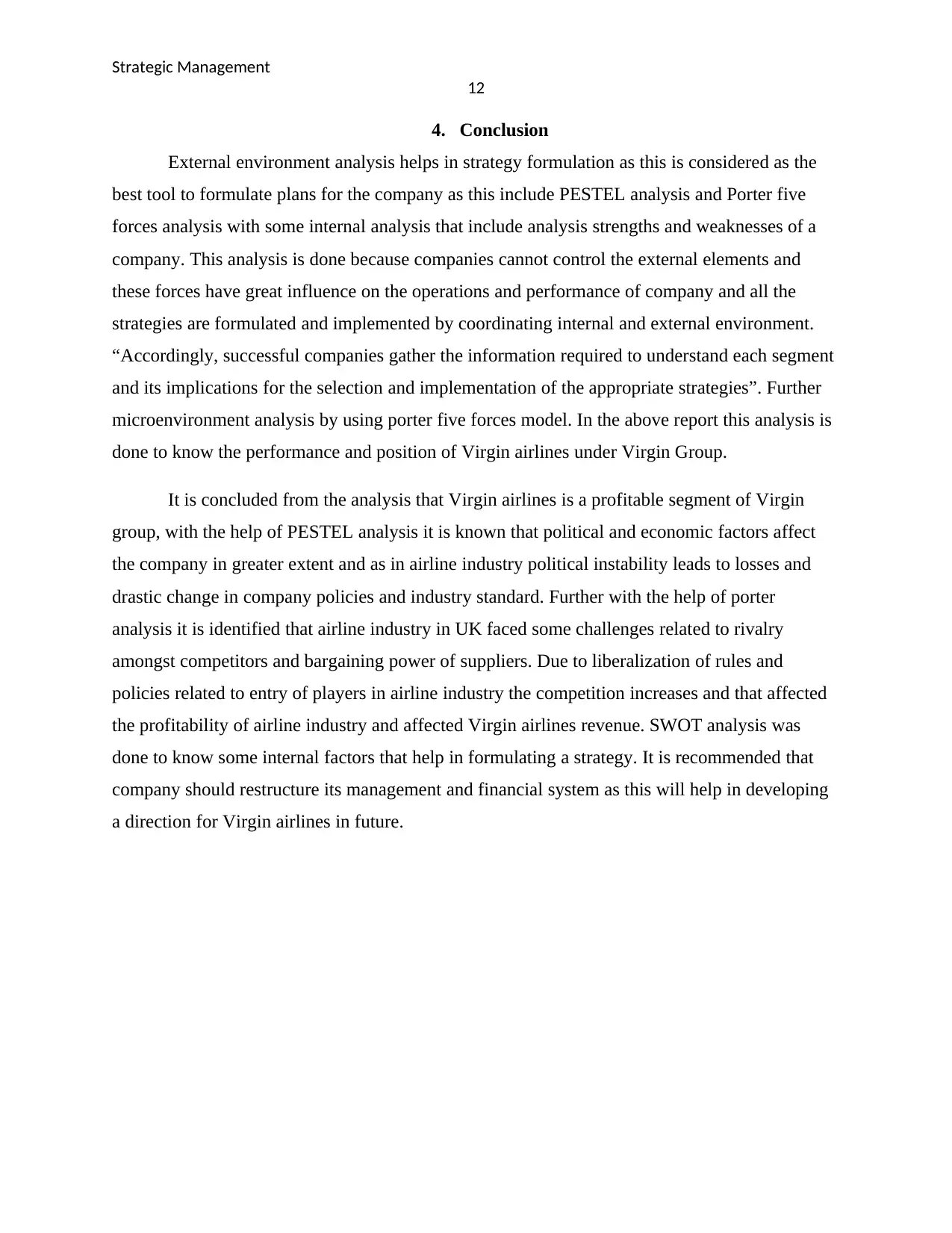
Strategic Management
12
4. Conclusion
External environment analysis helps in strategy formulation as this is considered as the
best tool to formulate plans for the company as this include PESTEL analysis and Porter five
forces analysis with some internal analysis that include analysis strengths and weaknesses of a
company. This analysis is done because companies cannot control the external elements and
these forces have great influence on the operations and performance of company and all the
strategies are formulated and implemented by coordinating internal and external environment.
“Accordingly, successful companies gather the information required to understand each segment
and its implications for the selection and implementation of the appropriate strategies”. Further
microenvironment analysis by using porter five forces model. In the above report this analysis is
done to know the performance and position of Virgin airlines under Virgin Group.
It is concluded from the analysis that Virgin airlines is a profitable segment of Virgin
group, with the help of PESTEL analysis it is known that political and economic factors affect
the company in greater extent and as in airline industry political instability leads to losses and
drastic change in company policies and industry standard. Further with the help of porter
analysis it is identified that airline industry in UK faced some challenges related to rivalry
amongst competitors and bargaining power of suppliers. Due to liberalization of rules and
policies related to entry of players in airline industry the competition increases and that affected
the profitability of airline industry and affected Virgin airlines revenue. SWOT analysis was
done to know some internal factors that help in formulating a strategy. It is recommended that
company should restructure its management and financial system as this will help in developing
a direction for Virgin airlines in future.
12
4. Conclusion
External environment analysis helps in strategy formulation as this is considered as the
best tool to formulate plans for the company as this include PESTEL analysis and Porter five
forces analysis with some internal analysis that include analysis strengths and weaknesses of a
company. This analysis is done because companies cannot control the external elements and
these forces have great influence on the operations and performance of company and all the
strategies are formulated and implemented by coordinating internal and external environment.
“Accordingly, successful companies gather the information required to understand each segment
and its implications for the selection and implementation of the appropriate strategies”. Further
microenvironment analysis by using porter five forces model. In the above report this analysis is
done to know the performance and position of Virgin airlines under Virgin Group.
It is concluded from the analysis that Virgin airlines is a profitable segment of Virgin
group, with the help of PESTEL analysis it is known that political and economic factors affect
the company in greater extent and as in airline industry political instability leads to losses and
drastic change in company policies and industry standard. Further with the help of porter
analysis it is identified that airline industry in UK faced some challenges related to rivalry
amongst competitors and bargaining power of suppliers. Due to liberalization of rules and
policies related to entry of players in airline industry the competition increases and that affected
the profitability of airline industry and affected Virgin airlines revenue. SWOT analysis was
done to know some internal factors that help in formulating a strategy. It is recommended that
company should restructure its management and financial system as this will help in developing
a direction for Virgin airlines in future.
Paraphrase This Document
Need a fresh take? Get an instant paraphrase of this document with our AI Paraphraser
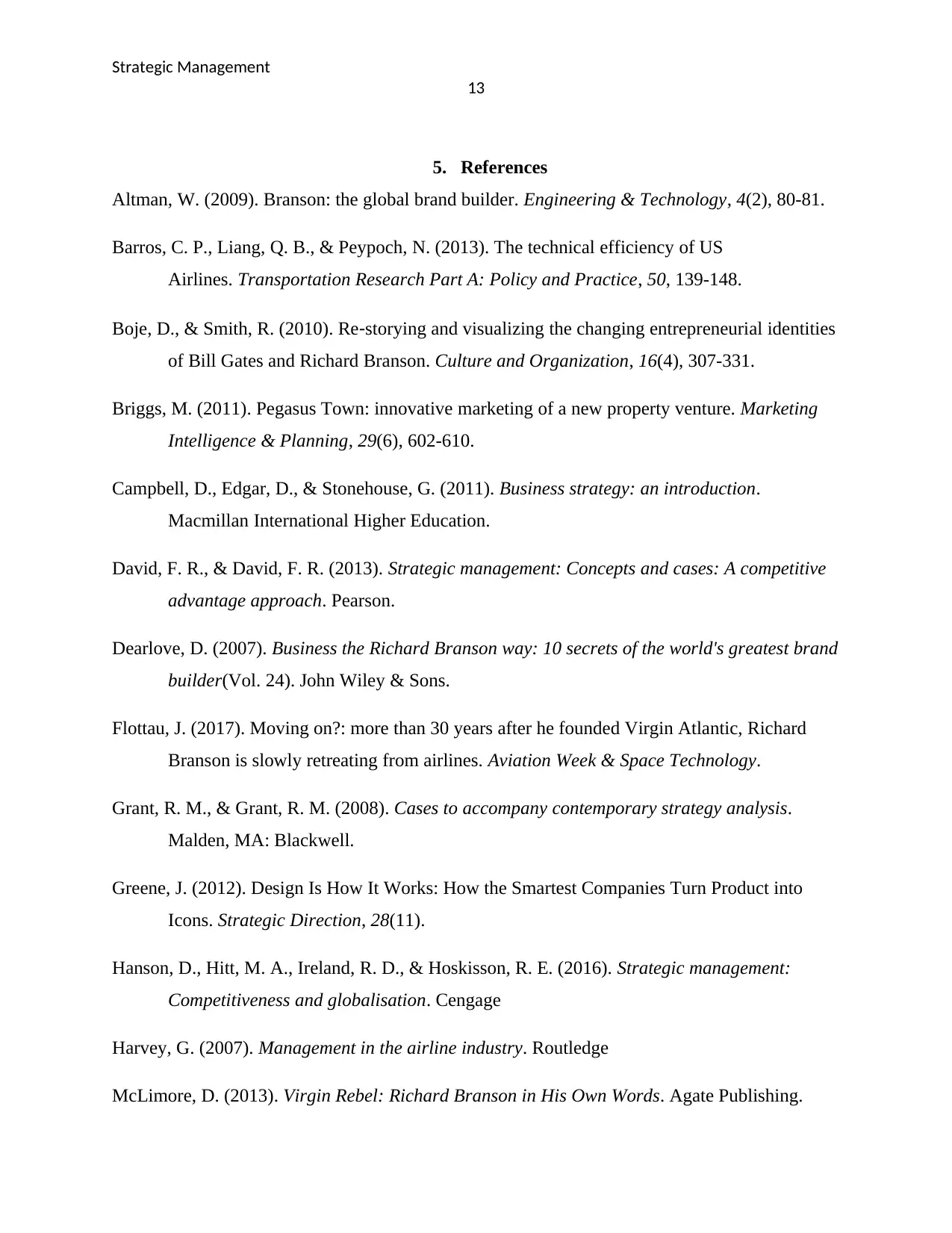
Strategic Management
13
5. References
Altman, W. (2009). Branson: the global brand builder. Engineering & Technology, 4(2), 80-81.
Barros, C. P., Liang, Q. B., & Peypoch, N. (2013). The technical efficiency of US
Airlines. Transportation Research Part A: Policy and Practice, 50, 139-148.
Boje, D., & Smith, R. (2010). Re‐storying and visualizing the changing entrepreneurial identities
of Bill Gates and Richard Branson. Culture and Organization, 16(4), 307-331.
Briggs, M. (2011). Pegasus Town: innovative marketing of a new property venture. Marketing
Intelligence & Planning, 29(6), 602-610.
Campbell, D., Edgar, D., & Stonehouse, G. (2011). Business strategy: an introduction.
Macmillan International Higher Education.
David, F. R., & David, F. R. (2013). Strategic management: Concepts and cases: A competitive
advantage approach. Pearson.
Dearlove, D. (2007). Business the Richard Branson way: 10 secrets of the world's greatest brand
builder(Vol. 24). John Wiley & Sons.
Flottau, J. (2017). Moving on?: more than 30 years after he founded Virgin Atlantic, Richard
Branson is slowly retreating from airlines. Aviation Week & Space Technology.
Grant, R. M., & Grant, R. M. (2008). Cases to accompany contemporary strategy analysis.
Malden, MA: Blackwell.
Greene, J. (2012). Design Is How It Works: How the Smartest Companies Turn Product into
Icons. Strategic Direction, 28(11).
Hanson, D., Hitt, M. A., Ireland, R. D., & Hoskisson, R. E. (2016). Strategic management:
Competitiveness and globalisation. Cengage
Harvey, G. (2007). Management in the airline industry. Routledge
McLimore, D. (2013). Virgin Rebel: Richard Branson in His Own Words. Agate Publishing.
13
5. References
Altman, W. (2009). Branson: the global brand builder. Engineering & Technology, 4(2), 80-81.
Barros, C. P., Liang, Q. B., & Peypoch, N. (2013). The technical efficiency of US
Airlines. Transportation Research Part A: Policy and Practice, 50, 139-148.
Boje, D., & Smith, R. (2010). Re‐storying and visualizing the changing entrepreneurial identities
of Bill Gates and Richard Branson. Culture and Organization, 16(4), 307-331.
Briggs, M. (2011). Pegasus Town: innovative marketing of a new property venture. Marketing
Intelligence & Planning, 29(6), 602-610.
Campbell, D., Edgar, D., & Stonehouse, G. (2011). Business strategy: an introduction.
Macmillan International Higher Education.
David, F. R., & David, F. R. (2013). Strategic management: Concepts and cases: A competitive
advantage approach. Pearson.
Dearlove, D. (2007). Business the Richard Branson way: 10 secrets of the world's greatest brand
builder(Vol. 24). John Wiley & Sons.
Flottau, J. (2017). Moving on?: more than 30 years after he founded Virgin Atlantic, Richard
Branson is slowly retreating from airlines. Aviation Week & Space Technology.
Grant, R. M., & Grant, R. M. (2008). Cases to accompany contemporary strategy analysis.
Malden, MA: Blackwell.
Greene, J. (2012). Design Is How It Works: How the Smartest Companies Turn Product into
Icons. Strategic Direction, 28(11).
Hanson, D., Hitt, M. A., Ireland, R. D., & Hoskisson, R. E. (2016). Strategic management:
Competitiveness and globalisation. Cengage
Harvey, G. (2007). Management in the airline industry. Routledge
McLimore, D. (2013). Virgin Rebel: Richard Branson in His Own Words. Agate Publishing.
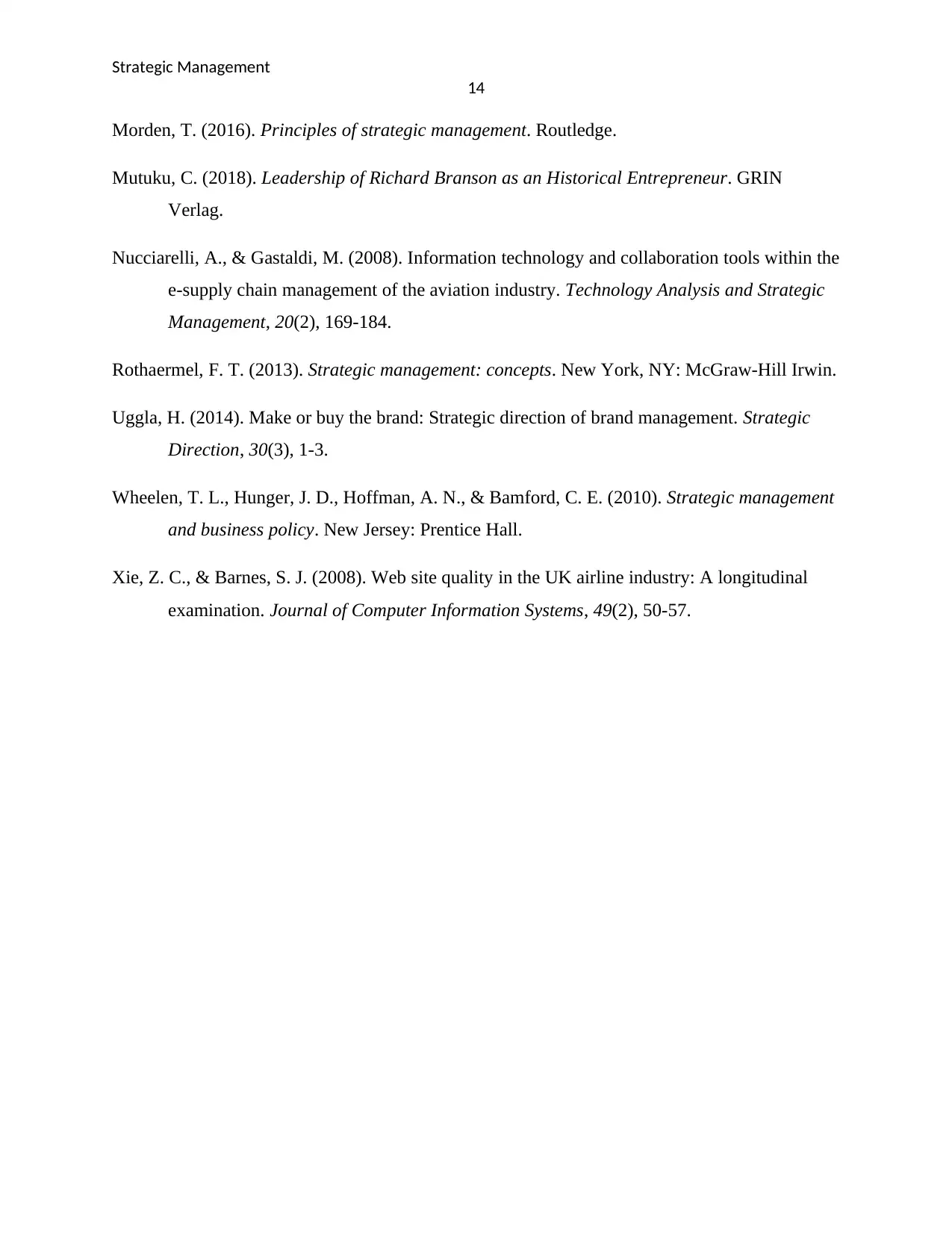
Strategic Management
14
Morden, T. (2016). Principles of strategic management. Routledge.
Mutuku, C. (2018). Leadership of Richard Branson as an Historical Entrepreneur. GRIN
Verlag.
Nucciarelli, A., & Gastaldi, M. (2008). Information technology and collaboration tools within the
e-supply chain management of the aviation industry. Technology Analysis and Strategic
Management, 20(2), 169-184.
Rothaermel, F. T. (2013). Strategic management: concepts. New York, NY: McGraw-Hill Irwin.
Uggla, H. (2014). Make or buy the brand: Strategic direction of brand management. Strategic
Direction, 30(3), 1-3.
Wheelen, T. L., Hunger, J. D., Hoffman, A. N., & Bamford, C. E. (2010). Strategic management
and business policy. New Jersey: Prentice Hall.
Xie, Z. C., & Barnes, S. J. (2008). Web site quality in the UK airline industry: A longitudinal
examination. Journal of Computer Information Systems, 49(2), 50-57.
14
Morden, T. (2016). Principles of strategic management. Routledge.
Mutuku, C. (2018). Leadership of Richard Branson as an Historical Entrepreneur. GRIN
Verlag.
Nucciarelli, A., & Gastaldi, M. (2008). Information technology and collaboration tools within the
e-supply chain management of the aviation industry. Technology Analysis and Strategic
Management, 20(2), 169-184.
Rothaermel, F. T. (2013). Strategic management: concepts. New York, NY: McGraw-Hill Irwin.
Uggla, H. (2014). Make or buy the brand: Strategic direction of brand management. Strategic
Direction, 30(3), 1-3.
Wheelen, T. L., Hunger, J. D., Hoffman, A. N., & Bamford, C. E. (2010). Strategic management
and business policy. New Jersey: Prentice Hall.
Xie, Z. C., & Barnes, S. J. (2008). Web site quality in the UK airline industry: A longitudinal
examination. Journal of Computer Information Systems, 49(2), 50-57.
1 out of 15
Related Documents
Your All-in-One AI-Powered Toolkit for Academic Success.
+13062052269
info@desklib.com
Available 24*7 on WhatsApp / Email
![[object Object]](/_next/static/media/star-bottom.7253800d.svg)
Unlock your academic potential
© 2024 | Zucol Services PVT LTD | All rights reserved.





